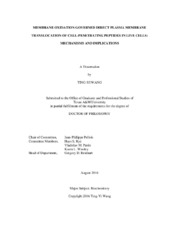| dc.contributor.advisor | Pellois, Jean-Philippe | |
| dc.creator | Wang, Ting-Yi | |
| dc.date.accessioned | 2016-09-22T19:52:58Z | |
| dc.date.available | 2018-08-01T05:57:38Z | |
| dc.date.created | 2016-08 | |
| dc.date.issued | 2016-08-03 | |
| dc.date.submitted | August 2016 | |
| dc.identifier.uri | https://hdl.handle.net/1969.1/158117 | |
| dc.description.abstract | Cell-penetrating peptides (CPPs) enter cells primarily through escaping from endosomal compartments or directly translocating across the plasma membrane. Due to their capability of permeating into the cytosolic space of the cell, CPPs are utilized for the delivery of cell-impermeable molecules. However, the fundamental mechanisms and parameters managing the penetration of CPPs and their cargos through the lipid bilayer have not been fully determined. This hampers their usage as a tool to study biological processes as well as for future therapeutic applications. In this work, I report the first observation that the cell penetration of linear polyarginine CPPs is dependent on the cellular oxidation state. Peptide delivery efficiency and the entry mechanism were evaluated in live human cells using fluorescence microscopy and flow cytometry. Additionally, lipophilic fluorescent probes were employed to detect the cell membrane oxidation level. Lastly, the mechanism of peptides penetrating the oxidized membrane was studied using live cells and in vitro partitioning assays.
The presence of antioxidants and a hypoxic environment reduced the cell penetration of polyarginine CPPs. In contrast, oxidants promoted cytosolic entry with an efficiency proportional to the level of reactive oxygen species (ROS) generated within membranes. Moreover, a monoclonal antibody that recognizes oxidized lipids inhibited peptide penetration while extracellularly supplemented pure anionic oxidized lipids enhanced peptide transport into cells. The results support a model in which positively-charged peptides bind negatively-charged lipids present on the cell surface as a result of oxidative damage and cross the membrane via formation of inverted micelles. This may explain the variability in the cell delivery efficiency of a CPP in different experiments. These new findings therefore also provide opportunities for the design of future cell-permeable compounds and for optimization of delivery protocols. | en |
| dc.format.mimetype | application/pdf | |
| dc.language.iso | en | |
| dc.subject | Cell-penetrating peptide (CPP) | en |
| dc.subject | cell delivery | en |
| dc.subject | plasma membrane | en |
| dc.subject | cell culture | en |
| dc.subject | oxidative stress | en |
| dc.subject | oxidized lipids | en |
| dc.title | Membrane Oxidation Governed Direct Plasma Membrane Translocation of Cell-Penetrating Peptides in Live Cells: Mechanisms and Implications | en |
| dc.type | Thesis | en |
| thesis.degree.department | Biochemistry and Biophysics | en |
| thesis.degree.discipline | Biochemistry | en |
| thesis.degree.grantor | Texas A & M University | en |
| thesis.degree.name | Doctor of Philosophy | en |
| thesis.degree.level | Doctoral | en |
| dc.contributor.committeeMember | Rye, Hays | |
| dc.contributor.committeeMember | Panin, Vladislav | |
| dc.contributor.committeeMember | Wooley, Karen | |
| dc.type.material | text | en |
| dc.date.updated | 2016-09-22T19:52:58Z | |
| local.embargo.terms | 2018-08-01 | |
| local.etdauthor.orcid | 0000-0001-5536-925X | |


